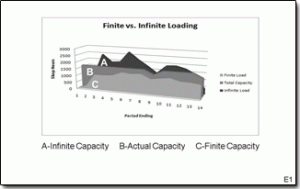Finite vs. Infinite Scheduling Comparison
Finite vs. Infinite Graphic Loading Comparison
Written by: Bill Kirchmier 5/7/2012
This document explains why it is useful to integrate Enterprise Resource Planning (ERP) and Finite Capacity Scheduling (FCS) technology. ERP systems are based on the assumption that capacity resources are infinitely available; since they are not your scheduling results will not be feasible. In contrast FCS schedules are always feasible. The Finite vs. Infinite Loading graphic compares Graph (A) ICBP results with Graph (B) Actual Capacity available and Graph (C) FCS feasible scheduling. Identical data was used in both systems.
The document explains how integrating ERP and FCS technology delivers feasible schedules, coordinates material and capacity resources and eliminates of the need for pegging files. Combining high performance ERP material management with high performance FCS capacity management insures feasible schedules throughout the enterprise.
Material and capacity resources are codependent, building product requires both material and capacity resources.
FCS was first implemented in 1984 by three independent developers for three different clients; however computer speed and disc access times were insufficient and limited shop floor operations. By mid 190’s compute speeds and disc access time reached speeds capable of processing useful number of operations per minute and FCS sales expanded. Today the number of shop floor operations per minute exceeds 100,000 and increasing. Speed is no longer a consideration.
Manufacturing companies continue using outdated ICBP scheduling technology however are realizing moving to modern scheduling technology is necessary to remain competitive. Not only to gain production speed but also to produce feasible schedules. In contrast to ICBP unfeasible scheduling; FCS schedules are always feasible. The Finite vs. Infinite Loading graphic compares Graph (A) ICBP results with Graph (B) Actual Capacity available and Graph (C) feasible FCS scheduling. Identical data was used in both the ICBP and FCS scheduling examples.
Graph B represents actual capacity available
Graph A represents ICBP loading; schedules more capacity than available
Graph C defines FCS feasible solution; never exceeds capacity available.
Companies using ERP have an option to replace the ICBP scheduling module with FCS. Replacing ICBP scheduling with FCS supports; defining material and capacity resources in each job routing to coordinate and synchronized material and capacity.
ERP material management functions are retained when FCS replaces the ICBP module. Capacity management moves from unfeasible scheduling results to feasible effective results when interfaced with FCS. This significantly increases features available for modeling complex applications like HMLV and creates high level efficient production.
IPPSA does not market systems or software, contact FCS vendors for information on FCS systems. We invite you to join us for an IPPSA Production Scheduling Seminar to learn about the benefits of integrating ERP and FCS and to get information about combining the two systems.




